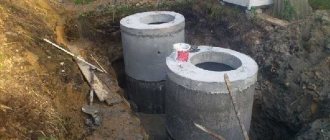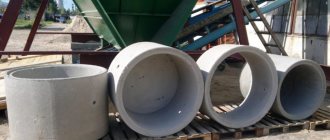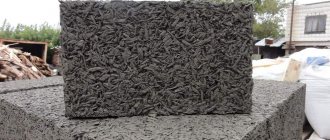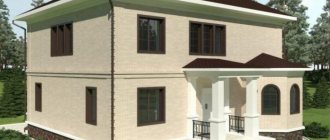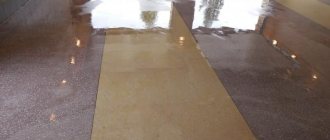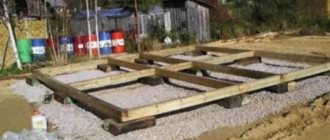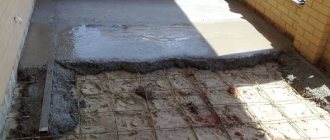The optimal solution for organizing the treatment of domestic wastewater in a private household is a monolithic concrete septic tank. To install it, you can hire specialists or do the installation yourself.
To organize the structure, you need materials that can be easily purchased at hardware stores.
How does a typical monolithic septic tank work?
Standard concrete septic tanks for cottages and houses have from one to three adjacent chambers. Between them, wastewater moves through overflow pipes built into the partitions.
Due to many days of settling, separation of insoluble sediment from water and the activity of microorganisms, natural wastewater purification occurs. All chambers of the septic system are used only for settling.
You cannot make a filter well adjacent. Over time, this will lead to deformation of the entire septic tank, so you need to install a filter system separately. It must be selected based on the area and the desired quality of cleaning.
Image gallery
Photo from
A single-chamber version of a sewerage structure is essentially a storage tank designed for the accumulation and subsequent pumping of wastewater
The two-chamber version, in addition to storing wastewater, also purifies it. During settling, wastewater is separated from insoluble sludge and flows into the post-treatment system
The more chambers in the septic tank, the higher the degree of purification and disinfection of wastewater. In addition to gravitational forces, anaerobic bacteria also participate in processing
Treatment facilities for independent sewerage can be poured on site or constructed from prefabricated concrete modules
Single-chamber storage design
Double chamber septic system
Three-stone concrete septic tank
Factory-produced concrete modules
This can be a free-standing well, a filter trench or a filtration field. The purification system can be installed after installing a monolithic septic system, but in this case the trenches will have to be dug manually. It will be impossible to use the equipment, as it can damage pipes and ceilings.
Types of rings
Concrete septic tanks come in two main varieties - reinforced concrete rings and monolithic. For the first option, ready-made rings are used. Reinforced concrete rings with internal diameters from 700 mm to 2000 mm and heights from 300 to 900 mm are available for sale. They also require accompanying elements—top and bottom covers.
The design of the rings requires careful sealing, especially if such a concrete septic tank is installed at a high groundwater level. The monolithic version is usually poured directly at the installation site.
If you decide to build a concrete septic tank with your own hands, then it is better to use reinforced concrete rings for installation. This design is easier to construct and, if necessary, much easier to disassemble. The design diagram of the septic tank is shown in Figure 1.
Scheme of a single-chamber septic tank
A septic tank that has one chamber is called a drain pit. Its device does not involve multi-stage treatment and serves primarily for storing sewage with subsequent pumping.
Waste is pumped out and transported using a special machine. The disadvantage of such a drainage system is its rapid filling and costly maintenance.
Such a drain pit needs to be pumped out every 3-6 months. It requires the least construction costs, but in the long run the cost of maintenance exceeds the savings
The depth in the diagram of this concrete septic tank is 2 m. The width of the walls is 1.5 m. This septic tank has a volume of 3.15 cubic liters and is intended to accommodate no more than two people. Due to lack of cleaning and draining, the container quickly overflows.
Installation ↑
The installation of a concrete septic tank, depending on the chosen option, differs in the type of work.
To arrange a monolithic two-chamber structure with your own hands, you must adhere to the following rules:
- compound. Do not use concrete whose grade is lower than B15. The optimal mixture will be the following composition: cement - 400 kg, liquid additive superplasticizer S-3 - 5 l, sand - 600 kg, water - 200 l, crushed stone - 1200 kg;
- sizes. The thickness of the walls and base of the product is from 20 cm, the thickness of the partitions is 15 cm;
- distance. The distance from the reinforcement bar to the concrete surface should be 3 cm;
- additional reinforcement. Necessary if the pit is rectangular in shape.
The procedure for installing a septic tank with your own hands is as follows:
For a family of 6-8 people, a Topas 8 septic tank is quite suitable. Find out how much it will cost from the article: Topas 8. How to hide pipes in the toilet behind plastic panels, see the photo in the article.
Digging a hole
The dimensions of the pit are calculated on the basis that a volume of 1.5 m3 is sufficient for a family of 3-4 people. Prepare it using a regular shovel in the shape of a rectangle or square. Work lasts on average from 1 to 2 days. The bottom and walls of the pit must be level;
Photo: pit preparation
Construction of formwork
To reduce material costs, you can use the sliding formwork method. To do this, it is installed only on half of the structure. After the first part has hardened, it is moved to the second. This method also allows the concrete to be placed more evenly in the space between the formworks.
The following materials will be required for the work:
- as chipboard panels;
- pieces of plastic pipes that may remain after installing a sewage system coming from the house;
- reinforcing bars;
- for the rigidity of the shields, pieces of wooden beams.
When creating a sealed structure, at this stage it is necessary to fill the base and leave it to harden for several days.
Photo: pouring the concrete foundation of the pit
After preparing the necessary materials, you need to proceed to the construction of the formwork:
- carry out the installation of panels, which are secured to each other using wooden beams;
- prepare holes for drainage. To do this, holes are cut out in the formwork every 30 cm, equal in diameter to the pipe scraps. They should be driven 5 cm into the ground so that they do not jump off when the structure is poured with concrete;
- Pipes that come from the house are passed through the formwork into the pit.
Photo: installation of formwork
Concrete works
Before pouring the solution, it is necessary to install reinforcing elements in it to enhance the strength of the structure.
Next you need to do the following:
- pour the solution into the first part of the pit, then wait for it to harden for 2 days;
- remove the formwork and move it to the second compartment;
- pour the solution into the second chamber and wait until it hardens completely.
Photo: pouring the walls
Next, you should begin to divide the structure into two compartments, equal in volume: to clean the wastewater and drain it through the filter bottom into the soil. Bricks, stones, and concrete blocks are used as wall materials.
At this stage, it is important to maintain the height of the hole. It should be 0.5 m lower than the input one.
Covering the septic tank
They move on to the next stage after 2 weeks. This is done in order to give the structure strength to withstand heavy loads. If small cracks have formed on the walls, they can be repaired with concrete mortar.
The procedure for covering works:
- they place channels for laying floors on them;
- install shields from boards with sides that create the boundaries of the hatch openings. They are positioned in such a way that through the hole it is possible to get into both parts of the septic tank;
- install pipes: ventilation supply and outlet;
Photo: ceiling installation and ventilation pipe installation
- lay reinforcement to enhance the strength of the structure;
- fill with cement mortar.
Photo: pouring the ceiling with cement mortar
At this stage, the installation of a monolithic concrete septic tank is completed. The result is practical equipment that is suitable as a sewer system for a private home.
Photo: hatch equipment
To install concrete factory septic tanks, you should also prepare a pit. Its dimensions and installation conditions can be read in the equipment instructions. The finished structure is connected to the sewer, taking into account that all pipes must be laid at a slope of 2%.
Scheme of a two-chamber septic tank
In this system, water undergoes preliminary settling before being discharged or pumped. According to sanitary standards, such water can be discharged into the ground. The advantages of this system lie in its compactness. With the same volume, two free-standing containers made of reinforced concrete rings take up more space than a monolithic concrete structure.
The diagram shows the proportions of the septic system. The optimal size of the receiving chamber should exceed the volume of the second settling tank in a ratio of 1:3 (+)
This septic tank has an internal concrete partition, which allows the water to settle in two stages. In addition, it can be equipped with a sensor that signals overflow. The second overflow at the opposite end of the container is located slightly lower than the first, which eliminates the return of wastewater to the receiving compartment and ensures spontaneous overflow of the settled liquid into the next chamber.
Installation Tips
- To prevent the well from freezing, its chambers should be insulated.
- It is advisable to install ventilation pipes on each of the containers.
- To increase the strength of the structure, concrete rings can be connected with metal brackets.
- When building a septic tank, it is best to rent special equipment that will lay rings of concrete in dug holes. For the same reason, excavation work must be carried out first before laying the cameras.
- When blocking each of the wells, it is necessary to take care of creating covers with hatches that allow you to monitor the condition of the septic tanks.
Thus, the construction of a septic structure from concrete rings will solve the problem with the sewerage of private houses. This design will cope with large volumes of waste, preventing soil contamination.
Proper care of your septic system
During operation, any sewer pipes are periodically coated on the inside with a greasy coating, which reduces their throughput. It must be removed with special means. They can be chemical or bacterial. Products based on microorganisms are preferable, since they do not spoil the pipes and do not lead to the death of the microflora inside the septic tank.
In winter, when the temperature drops to -25 degrees Celsius, it is necessary to insulate the hatch openings. Otherwise, the processes of processing organic matter in containers will slow down, which will lead to reduced purification.
Image gallery
Photo from
Effluent from a septic tank cannot be immediately discharged onto the terrain for soil treatment, because they are only 60% purified. To recycle water, underground post-treatment is needed, one of the options is a filter well
If the area of a suburban plot allows, an underground soil treatment system is arranged in the form of a group of infiltrators
As an option for a horizontally oriented system, filtration fields are used, which are a structure of perforated pipes laid on a soil filter
The functions of a filtration field or a group of infiltrators can be successfully performed by a filter trench, which is installed to collect a small volume of purified wastewater into the ground.
Absorption well in post-treatment
Installation of infiltration cassettes
Filtration field for ground tertiary treatment
Disposal via filter trench
How to use treated wastewater
A septic tank can be used to organize watering of plants and trees in a personal plot. Purified water has a small percentage of contamination (10 -15%).
They are quite suitable for use for household purposes. This will significantly reduce water consumption for watering your garden or garden in the summer. This means it will save money.
The use of pumping equipment involves power consumption. To provide power, you can use a low-power solar panel and a battery
Within a couple of years of operation, the system will fully pay for itself, since with the help of solar energy converted into electricity, it is possible to reduce the consumption of energy supplied by centralized networks. The solar battery is quite capable of covering the pump's needs.
Image gallery
Photo from
If it is not possible to dispose of treated wastewater into the ground, it can be accumulated in sealed wells and used for watering plants and maintaining the territory
Wastewater that has passed through the ground treatment system can be discharged onto the terrain or into a drainage ditch
If local specifics allow, a perforated drainage pipe can be placed in a green area that does not have the status of a park or square
It is permissible to water ornamental plants with purified water. You cannot bathe or wash pets in it.
Storage tank for purified waste water
Drain for waste disposal
Disposal of waste water on the relief
Watering non-agricultural plants
The pump can pump out water from a secondary or tertiary settling tank, as well as excess sludge from the receiving chamber. The pumped out sludge can be used in compost maturation. It is used as an independent fertilizer or in a mixture with other components.
You can pour the remaining organic matter into the compost pit. This can include fallen leaves, weeds and manure. After three to four years of rotting, an excellent fertilizer is obtained that increases the fertility of the soil in the garden.

